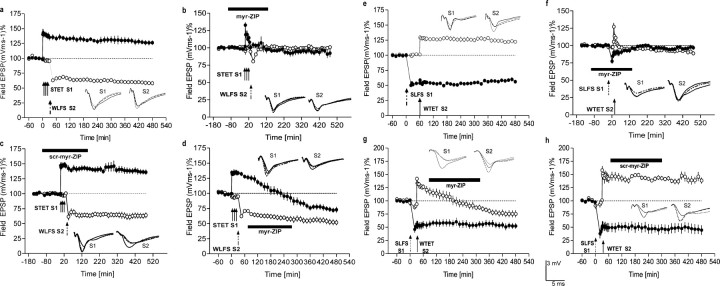Figure 3.
Effects of PKMζ inhibition on synaptic cross-tagging. a, Late LTP transforms cross-tagged early LTD synapses into persistent LTD. Induction of late LTP in S1 (filled circles) by STET was followed 30 min later by WLFS in S2 (open circles). Here, early LTD in S2 was transformed into late LTD, demonstrating synaptic cross-tagging between LTP and LTD (n = 7). b, Bath application of myr-ZIP 2 h before until 2 h after the tetanization of S1 prevented LTP and LTD induction (n = 7). S1 (filled circles) tetanized with high-frequency stimulation; 30 min later, WLFS was applied to S2 (open circles) to induce early LTD. c, Similar experiment as that in b but with the inactive scrambled peptide (1 μm) instead of myr-ZIP (n = 8). No effect on LTP, LTD induction, or cross-tagging was observed. d, PKMζ inhibition does not affect late LTP to cross-tagged early LTD synapse interactions that establish late LTD. Cross-tagging followed by the application of myr-ZIP 1 h after its induction reversed the maintenance of late LTP in S1 (filled circles); the early LTD in S2 (open circles) was nonetheless transformed into a late LTD regardless of the blockade of late LTP in S1 (n = 7). e, Late-LTD transformation of cross-tagged early LTP synapses. Induction of late LTD in S1 (filled circles) by SLFS was followed 1 h later by WTET in S2 (open circles; n = 7). Here, early LTP in S2 was transformed into late LTP, demonstrating synaptic cross-tagging between LTD and LTP. f, PKMζ inhibition blocks induction of LTD followed by LTP. Similar experiment as that in b but in a reverse manner (n = 7) [i.e., S1 with late-LTD induction (filled circles) and S2 with early LTP (open circles)]. g, PKMζ inhibition prevents LTP maintenance at cross-tagged synapses. The experiment is similar to e but with the subsequent application of myr-ZIP. The ability of late-LTD synapses (filled circles) to interact with and to prolong the maintenance at cross-tagged LTP synapses was prevented by myr-ZIP, revealing early LTP in S2 (open circles) with a subsequent long-lasting depression 5 h after tetanization (compared with baseline values before tetanization; n = 7; p < 0.05; Wilcoxon test). h, scr-myr-ZIP (1 μm) had no effect on cross-tagging (n = 4) [i.e., early LTP in S2 (open circles) was transformed into late LTP by the previous induction of late LTD in S1 (filled circles)]. Analog traces as well as symbols are similar to Figure 1. Error bars represent means ± SEM.

